The Remarkable Structure of the Qur’anThe Qur’an is a very unique book in terms of its composition. Its 114 chapters (or ‘Surahs’ in Arabic) are not arranged chronologically or thematically. Even within the individual chapters, numerous topics can be covered with sudden switches from one topic to another and then back again.
This unique structure at face value may appear to be disjointed. However, modern research has discovered a sophisticated structural coherence in the Qur’an known as ring composition.
THEORY OF RING COMPOSITION
Ring composition has been explained by Mary Douglas in her book “Thinking in Circles: An Essay on Ring Composition”. In ring compositions there must be a correspondence between the beginning and the end. It is structured as a sort of circle, or mirror image. The central meaning of the text is placed at its centre. The second half mirrors the first half, in reverse order — e.g., A, B, C, D, C’, B’, A’.
The correspondence usually involves the repetition of a striking or evident word or phrase, and there must be a clear thematic connection between the two sections. The correspondence serves to complete the circle and provide closure. Also, the internal sections – within the ring – must correspond to each other.
To put it in simple terms; ring composition is the equivalent of putting a mirror in the middle – what is mentioned in the first half will be reflected in the second half.
THE CIRCUMSTANCES OF THE QUR’AN’S REVELATION
Before getting into the ring composition of the Qur’an, it’s worth discussing the background and circumstances of the Qur’an’s revelation:
Prophet Muhammad, peace be upon him, could not read or write. The Qur’an itself confirms this:
“Those who follow the Messenger, the unlettered prophet, whom they find written in what they have of the Torah and the Gospel…” [Chapter 7, verse 157]
Throughout his life, prior to Prophethood, Muhammad did not have a reputation for poetry. In fact we know from history that at a personal level he disliked it and wasn’t a skilled poet. There are instances where he attempted to relate some poetry and would jumble the words up [1]:
Qatadah narrated, Aisha was asked: Did the Prophet, may the peace and blessings of Allah be upon him, use to relate anything from poetry?” She said: It was most detestable thing to him except that (at times) he used to relate a verse from the person of Banu Qays and he jumbled it up. Abu Bakr told him it was not like that. So the Prophet of Allah said, “By Allah I am not a poet and neither is it appropriate for me.”
The Qur’an was originally delivered to its first audience in the form of speech through recitation. Remarkably the Qur’an did not have the opportunity for an editorial process, as many verses were revealed on the spot as a response to unexpected questions and challenges that were brought forward to Prophet Muhammad from both believers and non-believers.
The 6,236 verses that make up the Qur’an were revealed gradually over a period of 23 years. It did not go through multiple revisions as it was revealed:
And those who disbelieve say, “Why was the Qur’an not revealed to him all at once?” Thus [it is] that We may strengthen thereby your heart. And We have spaced it distinctly. [Chapter 25, verse 32]
In light of these circumstances, one would expect the structure of the Qur’an to be incoherent. What we find however, is that it exhibits the sophisticated structure of ring composition.
THE RING COMPOSITION OF THE QUR’AN
Surah al-Baqarah, which we are going to use as a case study in this article, happens to be the longest chapter of the Qur’an and was revealed over a span of many years. Surah Al-Baqarah consists of 286 verses and can be divided into nine main sections based on theme/topic (verse numbers in parenthesis):
1. Faith vs. unbelief (1 – 20).
2. Allah’s creation and knowledge (21 – 39).
3. Deliverance of Law to Children of Israel (40 – 103).
4. Abraham was tested (104 – 141).
5. Ka’ba is the new qibla (142 – 152).
6. Muslims will be tested (153 – 177).
7. Deliverance of Law to Muslims (178 – 253).
8. Allah’s creation and knowledge (254 – 284).
9. Faith vs. unbelief (285 – 286).
Re-arranging this list to fit into a ring composition:
A Faith vs. unbelief (1 – 20).
——–B Allah’s creation and knowledge (21 – 39).
—————-C Deliverance of Law to Children of Israel (104 – 141).
————————D Abraham was tested (142 – 152).
——————————–E Ka’ba is the new qibla (153 – 177).
————————D’ Muslims will be tested (178 – 253).
—————-C’ Deliverance of Law to Muslims (254 – 284).
——–B’ Allah’s creation and knowledge.
A’ Faith vs. unbelief (285 – 286).
The coherence in the form of a ring composition is best illustrated in the diagram below (please click on picture to enlarge) [2]:
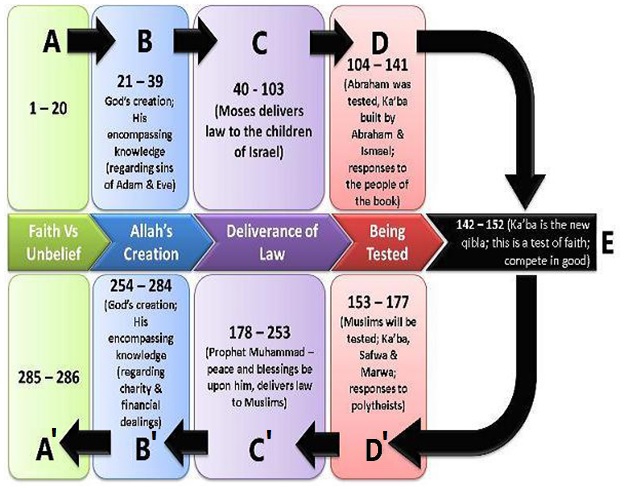
If we examine the 9 sections we find that they contain sub-ring compositions. So what we have is rings within rings (please click on pictures to enlarge) [3]:
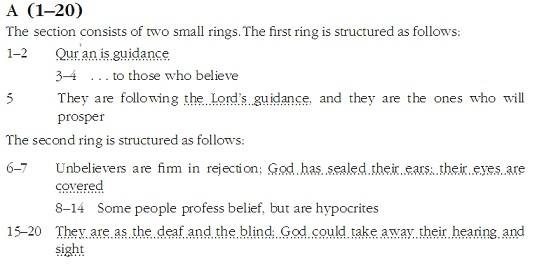
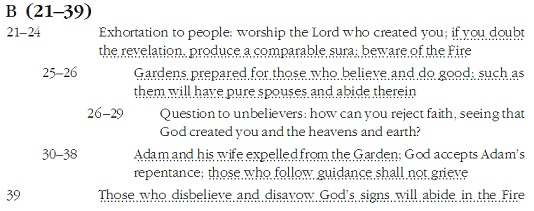
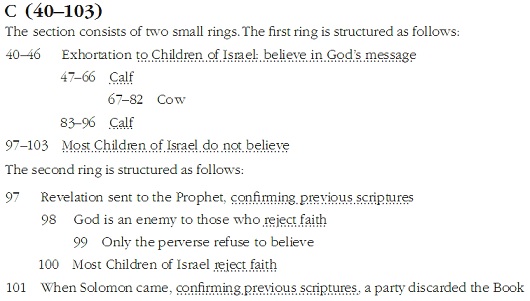
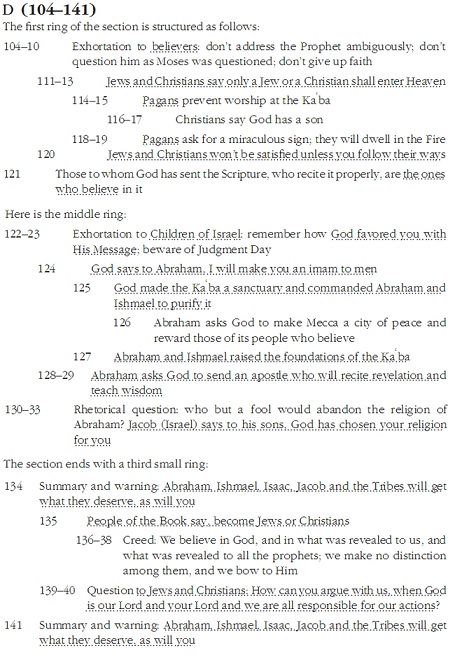
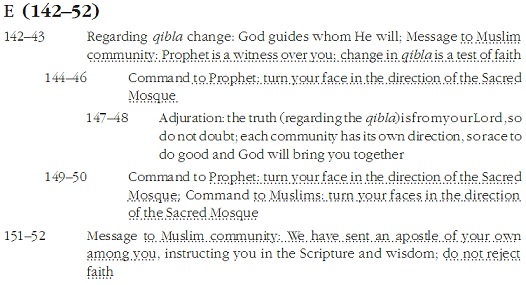
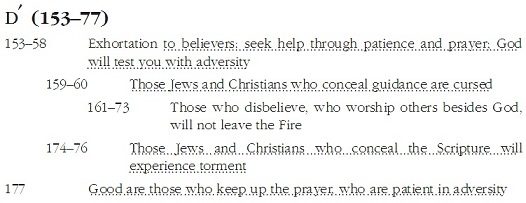
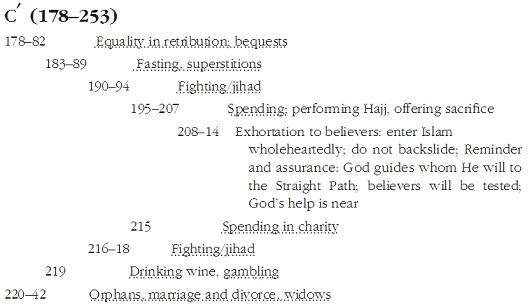


Here is a table showing parallels between the corresponding sections (the correspondences here are indicated horizontally):
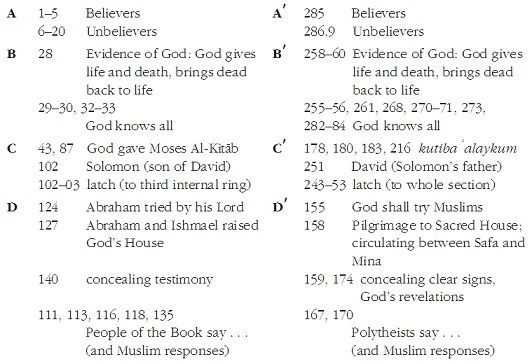
Finally, it’s worth paying special attention to a particular verse of Surah al-Baqarah, the 255th verse known as ‘Ayat al-Kursi’. This verse is considered the most excellent verse of the Qur’an, according to Prophet Muhammad. Its memorisation is highly encouraged, and it just so happens that it too exhibits a ring composition:
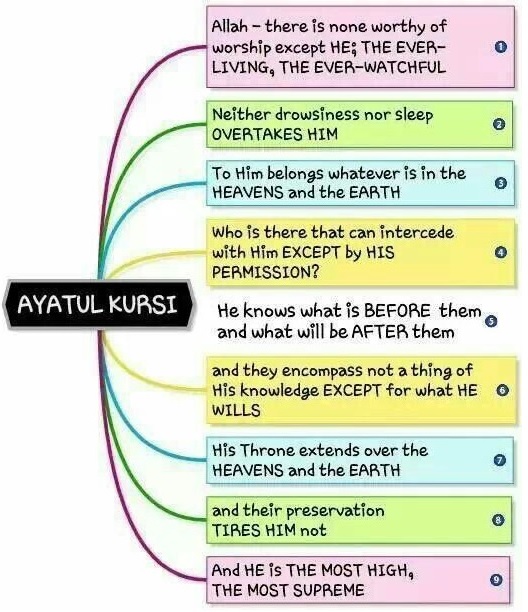
Raymond K Farrin, author of “Surat al-Baqarah – A Structural Analysis”, concludes on Surah al-Baqarah’s ring composition:
“Indeed this sura exhibits marvellous justness of design. It is precisely and tightly arranged, as we have seen, according to the principles of ring composition; even the section lengths fit perfectly in the overall scheme. Moreover, the precise structure serves as a guide, pointing to key themes in the sura. These occur, according to the logic of the pattern, at the centers of individual rings and, particularly, at the center of the whole sura. At the center of the sura, again, one finds instructions to face Mecca — this being a test of faith; identification of the Muslims as a new, middle community; and the message that all people, regardless of their qibla or spiritual orientation, should race to do good and God will bring them together.”
BENEFITS OF RING COMPOSITION
Ring composition has great exegetical application. For a ring structure not only holds the text together, but also gives focus to the important words and themes. By means of concentric patterning, ring composition calls attention to the centre – we are drawn to look here for the essential message. As Mary Douglas notes concisely, “The meaning is in the middle.” [4]
It also serves as an aid in memorisation, especially useful given the length of Surah al-Baqarah. In his study of ancient poetry, Cedric Whitman found that ring composition simultaneously performed both aesthetic and mnemonic functions. It aids memorisation by permitting the oral poet to easily recall the basic formulae of the composition during performances [5].
CONCLUSION
Given the difficult and protracted circumstances of the Qur’an’s revelation, one would expect it to be in disorder. However as this article has demonstrated, any such understanding reveals a lack of insight into the Qur’an’s sophisticated structure. Upon deep analysis of the Qur’an’s composition we see that it exhibits a remarkable structure. It is simply impossible for Prophet Muhammad, given that he could neither read nor write and had no reputation as a poet or literary expert, to have engineered such a structure himself. This represents compelling evidence that his inspiration for the Qur’an was God Almighty, as the Qur’an itself states:
“Your Companion is neither astray nor being misled. Nor does he say (aught) of (his own) desire. It is no less than inspiration sent down to him. He was taught by one mighty in Power.” [Chapter 53, verses 2-5]
References
1 - Tafsir at-Tabari, also see Tafsir Abdul Razzaq 3/86 Narration No. 2496 under Qur’an 36:69.
2 – Original diagram taken from article at Islam21c, “The Coherence of al-Baqarah”.
3 - Surat al-Baqarah – A Structural Analysis, Raymond Farrin, 2010.
4 – Mary Douglas, Thinking in Circles 16, 35.
5 – Cedric M. Whitman. Homer and the Heroic Tradition. Cambridge: Harvard UP, 1958.
copied from
http://manyprophetsonemessage.com/

